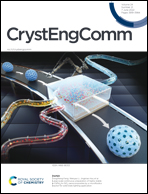Four Anderson-type [TeMo6O24]6−-based metal–organic complexes with a new bis(pyrimidine)-bis(amide): multifunctional electrochemical and adsorption performances†
Abstract
Four new isostructural POM-based metal–organic complexes, [H2X2(L)2(TeMo6O24)(H2O)6]·4H2O [X = Cu (1), Co (2), Ni (3) and Zn (4); L = N,N′-bis(4-pyrimidinecarboxamido)-1,4-benzene], were synthesized with a new rigid bis(pyrimidine)-bis(amide) ligand by varying the central metal under hydrothermal conditions, and characterized by means of single crystal X-ray diffraction, IR spectra and powder X-ray diffraction (PXRD). Complexes 1–4 exhibit similar 2D supramolecular structures based on the [H2X2(L)2(TeMo6O24)(H2O)6] dinuclear units linked through hydrogen bonds. Complexes 1–4 not only show good electrochemical sensing properties for BrO3−, NO2−, hydrogen peroxide and ascorbic acid, but can also be used as adsorbents for the removal of organic dyes such as gentian violet and methylene blue. Among them, complex 4 has the lowest detection limit and best dye adsorption capacity. Alternatively, the effect of central metals on the properties of the title complexes was discussed.
![Graphical abstract: Four Anderson-type [TeMo6O24]6−-based metal–organic complexes with a new bis(pyrimidine)-bis(amide): multifunctional electrochemical and adsorption performances](/en/Image/Get?imageInfo.ImageType=GA&imageInfo.ImageIdentifier.ManuscriptID=D2CE00504B&imageInfo.ImageIdentifier.Year=2022)


 Please wait while we load your content...
Please wait while we load your content...